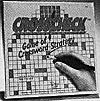
Designed by Anne C. Gray
TSR, Inc.
P.O. Box 756, Lake Geneva,
WI 53147
Released: April, 1985
Catalog No. 1018
Price: $17.00
Complexity: Beginner
Solitaire Suitability: Good
* * * 1/2
Cross/Check is a crossword puzzle game for two to four players, ages twelve to adult. The purpose of the game is to complete a chain of words on the playing board, extending from the center square to a player's individual home base. Play is both cooperative and competitive, with one player giving the clue definition for another.
Cross/Check comes in a bright yellow box, with an orange crossword design on the cover. Purely from the weight of the game box, one can feel one is getting one's money's worth. Inside are the game board (a four-piece jig-saw board that is coated with a wipe-off plastic), a chinamarking pencil (for writing on the board), four soft-cover books containing clues (including a children's clue book), and a 10sided die (to determine which clue is given, and the length of the answer). All of the components are of good quality, and even the box should stand up to a few years of use.
The game board is yellow, a shade or two darker than the box, and is sectioned off with a crossword design in own, including various blocking squares in ones or twos. The starting areas and home bases for the players are identified by colored areasturquoise, cerise, goldenrod, and verdant (blue, red, dark yellow, and green)with the starting lines in the center. The board is designed to be written on with the supplied chinamarking or grease pencil, and can be easily wiped off with dry paper towels. Do not-repeat, not-use water on the board, regardless of what it says in the books about lightly dampened; it will not remove the pencil marks and may possibly make them permanent, ruining the board.
Play is simple and straightforward. Each player rolls the die in turn; on a one the character must place a blocking square somewhere on the board; on a two the player may place a free letter anywhere on the board he wishes; on a three to ten this is the number of letters in the answer to the definition supplied. These definitions are found in the four clue books supplied with the game. Once the player has answered the definition (just as in a crossword puzzle), he or she may write that word anywhere on the board, and in any direction, as long as it fits in the space and does not create a nonword by joining another previously placed answer.
It generally pays to keep one's words close together, or to extend unconnectable words in a loose path toward one's home base in a corner of the board. If a word crosses one of the stars scattered about the playing surface when it is written onto the board, the player may roll the die again for another definition. A chain is not required to be all of a player's own answering-words from other players' chains may form part of the winning chain; all that is required is tracing an unbroken line of words from the starting line in the center to the player's colored home base area.
There are only 14 points to the rules for Cross/Check, and these are printed in the front of each of the four clue books. They are well written and fully explanatory.
In test-play, however, we found it helpful to mildly alter one rule: if a player rolls "1" on the die, he may either place the block or reroll-- if the reroll is a " 1 ", the player must place the blocking square. Too often a player was forced to waste a turn with placing a block when it was totally unnecessary or undesirable. In games involving younger children, it is also a good idea to let the children reroll "9" and "10" results. Longer words or phrases are very difficult for children to answer.
Strategy has a place in Cross/ Check, particularly in the placing of a word when it cannot be joined to the player's already existing chain. Properly placed words will extend the probable chain, even though they do not connectthe free letter writable on a "2" can serve to connect broken portions of the chain, or a short threeto five-letter word may easily make a bridge between two unconnected portions of the chain. Players should look for opportunities to block their opponents with words rather than with block squares placed on rolls of " 1 "; all too often, the block will impede the player who placed it later on.
Cross/Check is a very good family game. Among other things, it helps develop vocabulary and it fits right in with the current craze for triviamany of the answers in the clue books fall into that category (Carroll's first name is Lewis, for instance-a five-letter clue). I'm not going to insist that this is the greatest game of all time, but it is quite enjoyable, and anyone can win. My 15 yearold, whose English marks have not been the greatest recently, wins more frequently than would be expected.
More Adult Game Reviews
-
Game Review: Weatherslam Card Game
Game Review: Clue VCR Mystery Game
Game Review: Superstar Pro-Wrestling Game: Deluxe Edition
Game Review: Cross/Check Game of Crossword Strategy
Game Review: Dune Adventure Game (PB)
Back to Table of Contents -- Game News #8
To Game News List of Issues
To MagWeb Master Magazine List
© Copyright 1985 by Dana Lombardy.
This article appears in MagWeb (Magazine Web) on the Internet World Wide Web.
Other military history articles and gaming articles are available at http://www.magweb.com